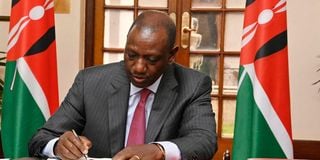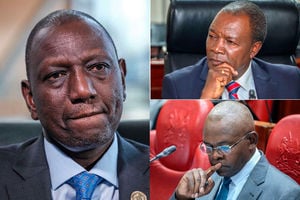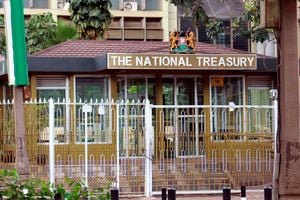
President William Ruto assents to the Supplementary Appropriation (No.3) at State House, Nairobi in November 2023.
A new wave of tax squeezes looms as the government sets an ambitious five-year economic turn-around plan that is mainly funded by enhanced collections by the Kenya Revenue Authority.
In the plan launched by President William Ruto yesterday, the government will deploy a Sh16.14 trillion war chest to bring down the cost of living by lowering the annual inflation rate to five per cent, eradicating hunger, and creating more jobs annually.
“These challenges demand urgent and resolute interventions to regain lost ground and align ourselves with our aspirations,” President Ruto said.
“This is why upon assuming office, our administration pledged to spearhead a radical economic turnaround, fostering inclusive growth and enhancing the livelihoods and welfare of all citizens, particularly those at the bottom of the economic pyramid. These commitments are intricately detailed within the Bottom-Up Economic Transformation Agenda,” he added.
The fourth medium-term plan (MTP IV), will be the last of the five-year MTP series that was started in 2008 by the Grand Coalition government of the late President Mwai Kibaki and former Prime Minister Raila Odinga.
The series was a long-term development blueprint aimed at transforming the country into a newly industrialising middle-income country.
The MTP IV will see President Ruto’s government spend Sh4.6 trillion more than the Sh11.54 trillion that his predecessor Uhuru Kenyatta spent on the Big Four Agenda, signalling increased taxation as Kenya has largely run out of space to increase its borrowing.
A big chunk of the additional funds will come from taxes, with the MTP IV identifying the hard-to-tax sectors such as agriculture and the informal and digital sectors as some of the areas that will be raided.
President Ruto’s plan relies on the taxman raising revenue collection from 16.5 per cent of GDP in the 2022/2023 fiscal year to 19.7 per cent in 2027/2028, and cutting the budget deficit to 2.9 per cent in 2028 from 5.6 per cent in 2023.
The State expects to bridge the gap between revenue and expenditure — and thus cut reliance on debt — through the implementation of the 2023 medium-term revenue strategy.
In its first year, the strategy calls for new taxes, such as motor vehicle circulation tax, a reintroduction of the minimum tax, withholding taxes on all imports and payments to supplies of public entities, and review of excise on alcohol and tobacco products.
There is also the expansion of the digital services tax to include local entities, a potential upward revision of rental income tax to match the rate of corporate tax, and the introduction of value-added tax (VAT) on non-core education services, excluding basic education and early childhood education.
“The government will scale up revenue collection efforts by the Kenya Revenue Authority by undertaking a combination of both tax administrative and tax policy reforms to achieve higher revenues as envisaged,” says the National Treasury in the fourth medium-term plan.
“The fiscal deficit to GDP, therefore, is projected to decline from 5.6 per cent in 2022/2023 to 2.9 per cent in 2027/2028.”
Raising the revenue performance to create room for lower debt uptake was also one of the key fiscal pillars in the third medium-term plan, which covered the period between 2018 and 2022.
MTP IV has also set out an ambitious target of cutting Kenya’s debt-to-GDP ratio to 53.7 per cent by the end of June 2028 from 68 per cent in June 2023. Public debt currently stands at Sh11.25 trillion and is projected to grow to Sh13.85 trillion by June 2028 as per the 2024 Budget Policy Statement.
However, the government struggled to hit the lofty targets and saw a deterioration in the various GDP ratios, indicating the difficulty facing Treasury in meeting the new measures outlined in the fourth plan.
Under the third MTP, revenue as a percentage of GDP declined from 17.5 per cent in 2019 to 16.5 per cent in 2023, against a target of 19.6 per cent.
This was partly attributed to an increase in hard-to-tax economic activities in the informal, digital and agriculture sectors, and the negative effects of the Covid-19 pandemic containment measures.
On the debt-to-GDP ratio, the expectation was that this would fall to 43.6 per cent by the end of the 2021/2022 fiscal year, while the fiscal deficit as a percentage of GDP was expected to fall to three per cent in the period.
The inability of the government to rein in spending has seen an increased reliance on borrowing to finance the budget and as a result, debt service costs have grown to become the single biggest expenditure item footed by taxpayers in the budget.
In the current fiscal year, the government projects to spend Sh1.866 trillion servicing public debt, up from Sh1.153 trillion in the year to June 2023.
In the first eight months of the fiscal year (July 2023 to February), total expenditure on public debt stood at Sh1.157 trillion, which included the Sh191.6 billion ($1.44 billion) spent in a partial buyback of the $2 billion 2014 Eurobond that matures in June.










